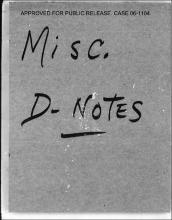| dc.contributor.author | Papian, William N. | en_US |
| dc.date.accessioned | 2009-06-10T20:38:19Z | |
| dc.date.available | 2009-06-10T20:38:19Z | |
| dc.date.issued | 1952-04 | en_US |
| dc.identifier | MC665_r12_6D-95 | en_US |
| dc.identifier.uri | http://hdl.handle.net/1721.3/40248 | |
| dc.description | Reprinted from the Proceedings of the I.R.E. Vol. 40, No. 4, April, 1952. | en_US |
| dc.description.abstract | A small, ring-shaped, ferromagnetic core with properly "rectangular" B-H characteristics may be operated so that its flux polarity reverses only when the correct combination of two or three magnetizing windings are coincidentally excited. Such cores may then be used as memory devices and assembled into a two- or three-dimensional memory system with storage-cell selection at the intersection of two or three space co-ordinates. Only a core which retains a large percentage of remanent flux of the proper polarity, in spite of repeated "nonselecting" disturbances, can be used as a coincident-current magnetic memory unit. Repetitive pulse-pattern testing designed to obtain quantitative data on the operation of such units, in the form of defined "information-retention ratios" and "signal ratios," indicates that only a few core materials are satisfactory. | en_US |
| dc.language.iso | en | en_US |
| dc.publisher | MIT Digital Computer Laboratory | en_US |
| dc.relation.ispartofseries | MIT DIC 6889 | en_US |
| dc.relation.ispartofseries | Project Whirlwind Controlled Distribution Memo 6D-95 | en_US |
| dc.relation.ispartofseries | Project Whirlwind Collection, MC665 | en_US |
| dc.title | A Coincident-Current Magnetic Memory Cell for the Storage of Digital Information | en_US |
| dc.type | Technical Report | en_US |
